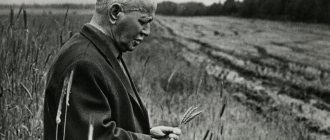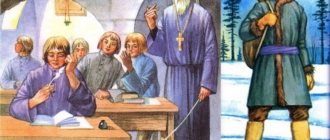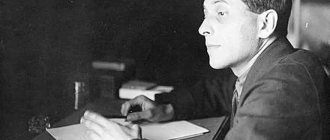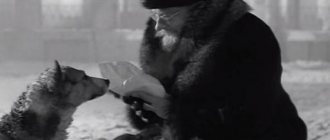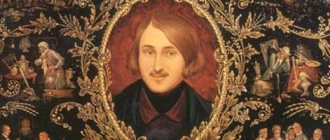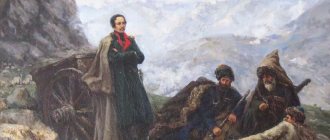Mikhail Afanasyevich Bulgakov is a great Russian classic of world literature, theater director, talented actor and playwright of the mid-20th century. The author of brilliant works that captivate from the first chapter with mystical plots and sharp satire. The creator of cult novels of the century, brilliant dramatizations that do not leave the theatrical stage today.
⭐⭐⭐⭐⭐
Mikhail Afanasyevich Bulgakov : childhood, youth, personal life, creativity and interesting facts.
In the writer’s life there were many conflicts with censors and critics, so his works were practically not published. The author gained wide fame posthumously when the whole world learned about such works as “The Master and Margarita”, “Heart of a Dog”, “Ivan Vasilyevich”, “The White Guard”.
Bulgakov's childhood years.
On May 3 (15), 1891, a boy Misha was born into the Kiev intelligent family of a professor at the Kiev Theological Academy and a teacher of the French language. He was the eldest child of the Bulgakov couple. Over time, Mikhail had two more brothers and four sisters.
Father, Afanasy Ivanovich, an educated man, fluent in five foreign languages, in order to feed his family, is forced to give history lessons in an institution for noble maidens and work as a clerk in the censor's office. Mother, Varvara Petrovna, nee Pokrovskaya, received a good education before her marriage, knew how to play the piano and taught at a girls’ gymnasium. After the birth of her children, she quit her job to devote her life to raising them.
Music was always playing in the Bulgakovs' house - Varvara Petrovna often played Chopin on the piano, Afanasy Ivanovich accompanied her with the violin, and the children sang romances.
From early childhood, Misha's parents tried to instill in their children a love of literature, encouraged independent study of the works of famous writers, organized home performances and did not miss a single theatrical production during the summer seasons of the Kyiv Merchants' Garden.
It was the warm family atmosphere and the work of N. Gogol that became the literary inspiration for the flowering of little Mikhail’s talent.
Personal life
Bulgakov's biography would not be complete without stories about his turbulent personal life. The writer was known as a great connoisseur of female beauty. The first wife, Tatyana Nikolaevna, went through a lot. Their marriage was initially not to the liking of their parents. After the wedding, the couple faced their first tragedy: Tatiana had to have an abortion, since the writer did not want to become a father. The wife listened to her husband and got rid of the child. Tatyana worked as a nurse and followed her husband everywhere.
In April 1924, the couple divorced due to the writer's new hobby. She became Lyubov Belozerskaya, who later received the status of Bulgakov’s second wife. She was the complete opposite of Tatiana. The couple led an active social life, and the writer’s popularity grew more and more. Lyubov Evgenievna was interested in everything, just not the house. She talked endlessly with her friends on the phone and was interested in horse riding and cars.
Despite the fact that Lyubov took the writer away from the family, in 1929 she herself found herself in Tatyana’s place. On his way he met Elena Shilovskaya, with whom they married on October 4, 1932. Elena became for Bulgakov not only a wife, but also a muse, literary secretary, biographer, friend and adviser. It was thanks to her that the world saw the writer’s unpublished works.
The youth of Mikhail Afanasyevich.
In 1901, Misha Bulgakov was enrolled in the Kiev men's gymnasium. Having completed his schooling with excellent marks, the future writer entered the Faculty of Medicine at Kiev University.
In 1907, Misha’s father, Afanasy Ivanovich, died from a long illness. To support her large family, Varvara Petrovna teaches private women's courses, and Mikhail tutors and works part-time as a conductor at the railway station.
The outbreak of the First World War found Bulgakov in his 4th year at university. During the 1915 conscription period, he signed up as a volunteer, but was classified as “unfit for military service” due to chronic kidney disease.
In 1916, M. Bulgakov received a doctor's degree with honors. The future doctor did not wait for the ceremonial presentation - he was leaving as a volunteer from the Red Cross to the front line of the southwestern front. First, young Bulgakov works in the Kamenets-Podolsk hospital, then in Chernivtsi. But in the fall it was recalled due to a catastrophic shortage of medical workers in the periphery. Mikhail received distribution from the Smolensk province and works as a zemstvo doctor in Sychevsky district.
1917 - Bulgakov accidentally becomes infected with diphtheria from a sick child at a reception. To dull the pain, he injects himself with morphine, which instantly causes organic dependence. His faithful wife Tatyana Lappa helps Mikhail Afanasyevich get rid of his addiction.
In the autumn of the same year, at his personal request, Bulgakov was transferred to the Vyazemsk hospital to the position of head of the venereal and infectious diseases departments. He petitions Moscow for permission to return to his homeland, but is refused. The 1917 revolution is in full swing in Kyiv.
The writer was able to come to Ukraine only in the spring of 1918 . At home, he opens a frequent venereology office.
Ukraine is going through unstable times - the German occupiers are replaced by Hetman Skoropadsky, then power passes to Symon Petliura, who is removed by the Red Army. In order not to end up in Petlyurovskaya, Bulgakov is forced to hide, but this does not help. In the fall of 1919, he was sent to Vladikavkaz, where Mikhail Afanasyevich worked as a military doctor for the White Guards.
In the winter of 1920, the Reds enter the city. He fails to leave with the previous power - the day before, Bulgakov fell ill with typhus. After recovery, the writer decides to retrain in a creative profession; a medical diploma threatens another link to the front line. He gets a job as the head of the theater section of the Vladikavkaz Revolutionary Committee.
Childhood and youth
Mikhail was born in Kyiv in the family of professor-theologian Afanasy Ivanovich and his wife Varvara Mikhailovna, who was raising seven children. Misha was the oldest child and, whenever possible, helped his parents manage the household. Of the other Bulgakov children, Nikolai, who became a biologist, Ivan, who became famous in emigration as a balalaika musician, and Varvara, who turned out to be the prototype of Elena Turbina in the novel “The White Guard,” became famous.
After graduating from high school, Mikhail Bulgakov entered the university at the Faculty of Medicine. His choice turned out to be connected solely with mercantile desires - both uncles of the future writer were doctors and earned very good money. For a boy who grew up in a large family, this nuance was fundamental.
During the First World War, Mikhail Afanasyevich served in the front-line zone as a doctor, after which he healed in Vyazma, and later in Kyiv, as a venereologist. In the early 20s, he moved to Moscow and began literary activity, first as a feuilletonist, later as a playwright and theater director at the Moscow Art Theater and the Central Theater of Working Youth.
The works of Mikhail Afanasyevich Bulgakov.
Working in Sychevsky district, he writes stories, the plots of which are based on real stories of treating patients - “Towel with a Rooster”, “Steel Throat” and “Star Rash” (from the series “Notes of a Zemstvo Doctor”).
1920 - as head of the theater sections of the Revolutionary Committee, M. A. Bulgakov presents stage premieres - a comedy about gangster groups in the civil war “Self-Defense” and a drama filming the collapse of the old ideal “The Turbine Brothers”.
The year 1921 in the writer’s biography is famous for his move to Moscow and work as a chronicler for the Trade and Industrial Bulletin. To survive, Bulgakov takes on any job - from a laborer to a letter processor for the Gudok newspaper. The publication was famous for its feuilletons by famous authors - E. Petrov, I. Babel, V. Kataev. In the spring of 1922, M. Bulgakov joined them. Not a single issue of the newspaper was published without his stories - “The Cup of Life”, “The Adventure of Chichikov”, “The Red Crown”. In his essays, the writer ridicules bourgeois opportunists and liars. I found ideas for inspiration in correspondent notes.
At the same time, Mikhail Afanasyevich was published in the pro-Soviet magazine “Nakanune”, on the pages of which the reader first saw the chapters of the novel “Notes on the Cuffs”.
In 1923, the writer begins work on The White Guard. The plot of the novel describes the understanding of the revolutionary events of Ukraine by one intelligent family. The author himself has repeatedly compared the story with the famous work “War and Peace” - the characters in “The Guard...” involuntarily find themselves drawn into political events, which forces them to make difficult choices. It is noteworthy that behind each of the heroes of the novel there is a real prototype - the Kyiv friends and relatives of the writer.
In 1923, M. Bulgakov wrote “The Diaboliad” - an event-driven phantasmagoria of the problems of the “little man” in Soviet democracy. The work was published a year later in the Nedra magazine. In the fall of 1923, he completed the story “Khan's Fire,” after which he was accepted into the Union of Soviet Writers.
1924 - Mikhail Afanasyevich writes the novel “Fatal Eggs”, the plot of which is perceived as a unique and subtle satire on the imperfections of Soviet politics. The work quickly became famous - in 1925 it was published in two editions, “Red Panorama” and “Nedra”. This is one of the first bestsellers of the great writer included in the “Diaboliad” series.
Bulgakov and morphine
One of the most powerful myths about Bulgakov is that of the morphine writer, who wrote his most powerful works in an altered state of consciousness. Often the writer’s admirers explain the devilish power of Bulgakov’s novel and his mystical visionary precisely in this way. This myth, like many others, has a real basis, but it is bizarrely distorted and retold.
This topic was first raised in 1927 with the publication of the story “Morphine” in the magazine “Medical Worker.” The story is adjacent to the cycle of largely autobiographical stories “Notes of a Young Doctor” - in them Bulgakov describes his work as a doctor in the village of Nikolskoye, Sychevsky district (Smolensk province) in 1916–1917. It was there that he accidentally became infected with diphtheria and was forced to inject himself with anti-diphtheria serum and then morphine to get rid of the excruciating pain.
The addiction happened quickly and unnoticed. Bulgakov unsuccessfully tried to cope with addiction and, apparently, secretly from his family, went to a Moscow clinic for treatment or consultation, but to no avail. The most difficult time for him was the early spring of 1918, when the writer returned home to Kyiv. The shock of the revolution and illness coincided with the Civil War and its horrors, violent mobilization - all these impressions are carefully described and analyzed in the story “Morphine”.
However, almost miraculously, Bulgakov managed to recover from morphine addiction - in the fall of 1921 he arrived in Moscow as a healthy man. So here we can say for sure: Bulgakov did not write anything while high. This is a real myth.
Productions by Mikhail Bulgakov in the theater.
In the spring of 1925, M. Bulgakov received an invitation from the Soviet director of the 2nd studio of the Moscow Art Theater B. Vershilov to stage “The White Guard” on stage. Bulgakov spends the whole summer at his desk, rewriting the novel into a play for the theater studio.
In September, he presented the troupe with a draft version of the drama called “Days of the Turbins.”
In the same year, for the Vakhtangov Theater he wrote the play “Zoyka’s Apartment”, about a heroine who, in the guise of a sewing workshop, opened a dating house in her apartment.
The autumn of 1926 presented two stage premieres by M. Bulgakov on different theater stages. “Days of the Turbins” sold out 13 times. “Zoyka’s Apartment” turned out to be no less successful. Despite the audience's success, critics rated the paintings as “everyman ideology” and “domestic counter-revolution.”
At the beginning of May 1926, to Bulgakov with a search, the basis of which was a Politburo directive to launch a campaign against emigrants who were supporters of the Russian world. Before the visit, a few days before the visit, the editor of the Rossiya publication, where Mikhail Afanasyevich often published, I. Lezhnev, was arrested and expelled from the country.
During the search, manuscripts of the story “Heart of a Dog” are confiscated; state security considered the work “particularly dangerous literature.” Thanks to the persistent petition of M. Gorky, the original can be returned three years later.
After his debut at the Moscow Art Theater, Bulgakov presented the theater with another play, “Running.” This is a drama of the 1920s, with a plot about the civil war and the fate of emigrating wealthy intellectuals. The work was received with a bang by the theater, but the repertoire chief does not allow the production.
The committee’s resolution was supported by J.V. Stalin with the wording: “pity for the anti-Soviet emigrant is nothing more than an attempt to justify the actions of the White Guard.” With such a resolution, M. A. Bulgakov instantly becomes a “banned” author.
In the summer of 1929, having no means of subsistence, Bulgakov wrote a letter to I. Stalin asking to leave the country, but was refused. The writer submits an application for voluntary withdrawal from the writers' union.
In the fall of the same year, he wrote a new play for the Moscow Art Theater, “The Cabal of the Saint,” about the persecution of a writer inconvenient for the kingdom. On the work, the Chief Repertoire Committee puts forward a resolution “an analogy between the disenfranchised sections of the population and the dictatorship of the proletariat.” In response, Bulgakov writes to I.V. Stalin a repeated request for migration, since he does not “have earnings in his native country.”
In April 1930, J.V. Stalin, by telephone call, advised M.A. Bulgakov to apply to the theater with a request for a position. In May, the writer officially begins working as an assistant director of the Moscow Art Theater. Mikhail Afanasyevich's theatrical duties included staging - he staged "War and Peace" and "Dead Souls".
In 1933, M. Bulgakov wrote the novel “The Master and Margarita.” He sees himself and his third wife, Elena Shilovskaya, as the prototype of The Master and Margarita. By 1938, a draft version of the “novel about the Devil” was ready, but the Master made amendments to it until his death.
At the same time, Mikhail Afanasyevich is working on theatrical productions of “Don Quixote”, and writing the drama “The Last Days” (about A.S. Pushkin), the libretto “Rachel” (based on Guy de Maupassant).
In the fall of 1939, the writer fell ill and doctors discovered he had hypertensive nephrosclerosis. Mikhail Afanasyevich began to quickly lose his sight and speech. To relieve pain, he takes morphine and dictates edits to the chapters of “The Master and Margarita” to his wife. The novel will be published in the Moscow magazine 26 years after the author’s death and will bring him worldwide recognition.
On March 10, 1940, M. A. Bulgakov died. His body was cremated, and his ashes were buried under the calvary stone at the Novodevichy cemetery.
The secrets of Mikhail Bulgakov's three wives: “first”, “forgotten”, “famous”
The first is Tatyana Nikolaevna, nee Lappa. Here she is in the photo back in her high school years. A girl from a good noble family, Tasya, as her relatives called her, was born in Saratov, where she graduated from high school. She met Bulgakov in Kyiv, when she first came to the city to visit her aunt Sofya Viktorovna Davidovich.
“Sofya Viktorovna really wanted someone to show Tasya the city,” says Elena Alyokhina. “She was friends with Bulgakov’s mother Varvara Mikhailovna, and she had the chance to show Misha the city. Love has begun.
However, the mother of the future writer, although she treated Tatyana well, was against this marriage. She believed that first a boy should graduate from university, get a specialty and get on his feet, and then he can get married. But Bulgakov categorically insisted on his own. Before the wedding, Tasya became pregnant and had an abortion. Subsequently, she said that she never wanted to have a child. Bulgakov never had his own children.
In April 1913, Bulgakov and Tasya got married. Here on the screen appears a photo of the house in Kyiv in which they lived, at Andreevsky Spusk, 13. Now there is a Bulgakov museum there. Mikhail Afanasyevich loved this house very much, describing it in the novel “The White Guard” and the play “Days of the Turbins”. The first year of the newlyweds passed in pink, and then the First World War began. Bulgakov, a student at the medical faculty of the Kyiv Imperial University of St. Vladimir, immediately began working with his wife - he was a brother of mercy, and she was a sister of mercy in the evacuation hospital, the patroness of which was Tatyana Nikolaevna’s mother. Soon the hospital was moved closer to the front line, and Bulgakov found himself on the Southwestern Front as a military doctor. Tatyana assisted him. It is interesting that all three of Bulgakov’s wives were sisters of mercy during the First World War.
Twice Tasya saved him from death. First time from drug addiction. Bulgakov described his condition at that moment in his autobiographical story “Morphine.” However, if the hero of the story, Doctor Polyakov, died from an overdose of morphine, then the morphine addict Bulgakov survived. He had to take the first dose of morphine not of his own free will, but after it he went. Drug addiction forced Bulgakov to write a letter of expulsion, and at the very beginning of 1918, he returned to Kyiv while passing through Moscow. It was there that Tatyana Nikolaevna pulled him out of the state of morphinism.
“Tatyana didn’t do anything: she threatened to leave, she threatened to commit suicide,” says Elena Alyokhina. - Ultimately, in some very cunning way, through the joint efforts of Tatyana, Bulgakov himself and his uncle Professor Nikolai Pokrovsky, we managed to pull Bulgakov out of this state of drug addiction. Nikolai Pokrovsky supplied Bulgakov through Tatyana with ampoules of morphine, which increasingly contained a dose of water. Thus, the dose was gradually reduced, and Bulgakov stopped depending on the drug.
Meanwhile, power in Kyiv changed with catastrophic speed: Skoropadsky, the Whites, Petlyura, the Reds. Bulgakov was assigned to the Caucasus in the White Army, where he served half of 1919 and part of 1920 as a military doctor. He did not serve long and very quickly caught typhus. At this time, the whites were retreating from the North Caucasus under the pressure of the Bolsheviks. Alekhina notes that Bulgakov was in a delirious state, with a temperature of about forty-two, but Tatyana was still going to go with him. However, Bulgakov’s colleague, another military doctor, told her that “if, madam, you want your husband to die in ten miles, then let’s go.” Tatyana stayed with her husband in Vladikavkaz and did not take him anywhere. She brought him out of this typhoid state. So she saved him the second time.
“Subsequently, Tatyana Nikolaevna told Leonid Parshin with great resentment that Bulgakov once called her a weak woman precisely because she could not take him to Batum and he did not go into exile,” says Elena Alyokhina. - Of course, she was incredibly offended.
Bulgakov's first wife in many ways helped him endure the hunger and cold of the early 1920s, when they lived in the writer's first Moscow apartment on Bolshaya Sadovaya, 10. They saved themselves as best they could. The gold chain that Tasya’s parents gave her for her wedding came to the rescue. As Tasya put it, “the chain was eaten.” Tatyana Nikolaevna would bite off a few links from this gold chain, take it to buy houses, and live on this money for quite a long time.
“They celebrated the New Year of 1924 at a party and used wax to tell fortunes,” continues Elena Alyokhina. — Tatyana told me that Misha kept getting lucky, but she had empty rings. She regarded this as a divorce. I told my husband about this. He began to dissuade her: “No, no, what are you talking about! Everything is fine!". However, Tatyana recalled: “I knew that he already had another one, this one.” She does not name “this one.” In fact, this other one has not yet existed. But Tatyana apparently felt that her husband’s attitude towards her was going somewhere.
In 1924 they separated, but for some time Bulgakov helped her financially. And when in 1925 Bulgakov happily brought Tatyana the beginning of his novel “The White Guard,” published in the magazine “Russia,” and she saw that the novel was dedicated to another woman, Lyubov Belozerskaya, she flew into a rage and tore up this magazine.
Nevertheless, Bulgakov did not forget Tasya, who, after divorcing him, married twice more. First, for the doctor Alexander Kreshkov. She went to Siberia with him. Tatyana Nikolaevna learned about Bulgakov’s death from the newspapers. After the funeral, she arrived in Moscow, where she met with Bulgakov’s widow, Elena Sergeevna, and his sisters. Everyone told her that before his death, Mikhail Afanasyevich called her and really wanted her to come.
— When she returned to Siberia, she found out that Alexander Kreshkov had destroyed everything she had from Bulgakov: photographs, letters, documents. Tatyana Nikolaevna had not been Bulgakov’s wife for fifteen years, but jealousy apparently lingered.
Tatyana Nikolaevna died in 1982 at the age of ninety. Shortly before her death, she managed to tell her memories to the Moscow Bulgakov scholar Leonid Parshin. They became the most valuable source about Bulgakov. The writer’s second wife, Lyubov Belozerskaya, also turned out to be a long-liver.
Bulgakov met her at the beginning of 1924 at an evening that Moscow writers organized in honor of the arrival of Alexei Nikolaevich Tolstoy from emigration. Belozerskaya also returned from emigration, who by that time had already separated from her first husband, feuilletonist Ilya Vasilevsky.
Lyubov Evgenievna arrived from abroad fashionably dressed. And Bulgakov was in a rather strange form, as Belozerskaya describes him: “He was in a hoodie without a belt and had patent leather boots on – black and yellow.” Belozerskaya called them chicken-like. Bulgakov was very offended and said that “if the perfumed lady who had just arrived from abroad knew how hard it was for me to get these shoes, she would not speak about them like that.”
Based on Belozerskaya’s stories about emigrant life, according to Alyokhina, Bulgakov wrote his play “Running.” For example, let us remember the scene when General Chernota, enraged by the howls of the muezzin calling the faithful to prayer, snatches a revolver and shoots into the air, screaming: “Damned city!” - Belozerskaya observed a similar reaction from Vasilevsky, who hated Constantinople. In addition, Belozerskaya points out that it was the memoirs of General Yakov Aleksandrovich Slashchev that were the basis for this play, and Slashchev became the prototype of General Khludov.
“Belozerskaya knew the top of the Red Army,” says Elena Alyokhina. “She was a very athletic woman: she went skiing, did horse riding, and completed a driving course. A woman driver in Moscow in those years was nonsense.
The novel “The White Guard”, the play “The Cabal of the Saint” (Molière), “Running” and several other works are dedicated to Lyubov Evgenievna. Alyokhina notes that it was during the years of living with Belozerskaya that Bulgakov’s creativity flourished. In the mid-1920s, “The Diaboliad” and the story “Fatal Eggs” were published, and the novel “The White Guard” was published, although not in full. Bulgakov, commissioned by the Art Theater, staged the novel, and the play “Days of the Turbins” was born. Unlike Bulgakov's first wife, Belozerskaya participates in his literary work. Lyubov Evgenievna, who knew French very well, helped him work on Molière, reading French-language sources in the library and taking notes.
Finally, Belozerskaya witnessed a telephone conversation between Bulgakov and Stalin in 1930. A year earlier, in 1929, all Bulgakov’s works were simultaneously banned. He is expelled from the Moscow Art Theater, where he was an assistant director.
— His letter to the Soviet government was a gesture of utter despair. The result of this letter was Stalin’s call to Bulgakov at the apartment on Bolshaya Pirogovskaya, 35A, where the writer also lived, says Elena Alyokhina. — The call was on April 18, the day after Mayakovsky’s funeral, at which Bulgakov was present. The bell rang, Belozerskaya picked up the phone, and a male voice said: “Comrade Stalin will talk to you now.” She conveyed this information to Bulgakov, and he pretended that it did not concern him, because he decided that it was a joke. A few minutes later the bell rings again. Bulgakov, as if scalded, runs to the phone, grabs the receiver and actually hears Stalin’s voice. He advised Bulgakov to get a job at the Moscow Art Theater. Bulgakov replied that he went, but was not accepted there. Then Stalin advised him to go again and expressed the hope that he would be received there. The next day, Bulgakov was carried into the Art Theater in his arms. He was reinstated as assistant director and worked at this theater until the end of 1936.
Lyubov Evgenievna listened to this conversation through the outlet tube. She wrote it down in her memories to the comma. Bulgakov recounted the conversation with the leader and his third wife Elena Sergeevna, whom he married literally two days after his divorce from Belozerskaya.
Lyubov Belozerskaya never married again and had no children. She worked at the publishing house “Khudozhestvennaya Literatura”, “Soviet Encyclopedia”, and in the editorial office of “Literary Gazette”. She edited the collected works of Vikenty Veresaev. Until 1956, Lyubov Evgenievna worked under Academician Tarle. She lived to be 92 years old. Here is a photograph of her in her house on Pirogovka several years before her death. It was to this house that Bulgakov brought Elena Sergeevna in 1932.
“I can’t say how the three of them lived for two or three months,” says Elena Alyokhina. – Ultimately, Bulgakov rented another apartment for Belozerskaya in this house. It was repaired, at first Bulgakov paid for it. Lyubov Evgenievna lived in this one-room apartment on Pirogovka, 35 until the end of her days. She died in 1987.
This was the third marriage for both Bulgakov and Elena Sergeevna. The father of Bulgakov's wife, Sergei Markovich Nuremberg, was a big fan of the theater. He wrote plays himself and organized the Russian Drama Theater in Riga. Elena Sergeevna’s sister Olga became a theater goer. She served in the Moscow Art Theater since 1918, and subsequently was the secretary of Vladimir Nemirovich-Danchenko. Olga told her younger sister Elena about the young Bulgakov. Elena Sergeevna saw the play “Days of the Turbins” and really wanted to meet this young playwright. In 1929 they met through mutual friends. Moreover, Elena Sergeevna did not want to come, but she was lured by the fact that Bulgakov would be visiting. They were next to each other at the table.
“She was wearing a silk dress, and the string of this dress came undone on her sleeve,” says Elena Alyokhina. “She asked her table neighbor, Mikhail Afanasievich, to tie this tie for her; she couldn’t do it with one hand. Bulgakov later said that he tied the tie, but for the rest of his life she tied him to herself with this tie.
Elena Sergeevna said: “We got married in the registry office.” That day, Bulgakov had a rehearsal at the Moscow Art Theater. He wrote a note to the director asking him to let him go early today, because today he had a “wedding at the registry office.” From October 1932 until Bulgakov's death in 1940, they lived together.
This “wedding” was preceded by Elena Sergeevna’s difficult divorce from the famous military figure Yevgeny Shilovsky. He even threatened suicide. The case was eventually resolved peacefully. The children were divided among themselves: the eldest remained with his father, and the youngest, Sergei, with his mother. According to Alyokhina, Bulgakov raised Seryozha Shilovsky as his son. They had a very warm relationship, and Bulgakov taught him a lot. Seryozha called him Potap.
“Elena Sergeevna completely became involved in Bulgakov’s literary work,” says the researcher. “She typed everything on a typewriter.” If Bulgakov destroyed his manuscripts, then she collected every piece of paper, thanks to which a significant part of Bulgakov’s archive was preserved. Her diaries have been preserved from 1932 until the end of Bulgakov’s life.
It is interesting that Elena Sergeevna rewrote her diary already in the 1960s. An edited version was published during her lifetime. Thus, we have a unique document called “The Diary of Elena Sergeevna Bulgakova” - the one that she wrote in reality during the course of events, and the one that she rewrote at the end of her life.
— This document is absolutely unemotional. She writes mostly in nominal phrases, very briefly and to the point. Splashes are rare. Very tactful attitude even towards enemies. Nevertheless, she very clearly recorded all the events in Bulgakov’s life by day, even by hour,” notes Alyokhina.
Another source of information is Bulgakov’s letters to her in the summer of 1938. In them he writes in detail about his work on the novel “The Master and Margarita”. Roman Bulgakov began writing in 1929. It had several editions. He destroyed the first one. There were different titles, subsequent stories were inserted. In October 1937, Elena Sergeevna recorded in her diary the title of the novel - “The Master and Margarita”. In 1937, Bulgakov painted the word “The End”. And in 1938, when Elena Sergeevna and her son Seryozha left for Lebedyan, Bulgakov set about reworking this novel. It was printed by Elena Sergeevna’s sister Olga Bokshanskaya. On July 24, 1938, printing of the last edition of the novel ends. Then Bulgakov began to edit it, but did not have time to finish the last version.
Elena Sergeevna also witnessed the creation of Bulgakov’s last play “Batum”, the main character of which is Stalin. Bulgakov wrote it for the leader’s 60th birthday, which fell in 1939. Back in 1936, Elena Sergeevna noted in her diary: “Misha is writing a play about Stalin.” She believed that this play would be Bulgakov's passport to a new literary life. In 1939, the play was accepted by the Moscow Art Theater and began to be rehearsed, but was banned by Stalin himself. When Bulgakov learned that the ban on the theater came personally from Stalin, he told his wife: “Lucy, he signed my death warrant.”
Bulgakov died in the arms of Elena Sergeevna on March 10, 1940 at the age of 48. Until the end of his days, the writer’s widow did everything to ensure that his memory remained forever. It is symbolic that she died in 1970, a day after watching the film based on Bulgakov’s play “Running”.
Personal life of Mikhail Afanasyevich.
Mikhail Bulgakov met his first wife Tatyana Lappa while studying in 1908. The feeling between the young people is so strong that Misha leaves the university and goes to his beloved in Saratov. In April 1913, the couple got married.
When the writer is sent to the front, Tatyana goes with him as a medical assistant. Both spouses face not only the test of war. After 11 years of marriage, a devoted wife becomes faceless next to the rising creator. The marriage broke up in October 1924, and the divorce was filed in March 1925. Mikhail Afanasyevich leaves to meet a new muse, to the sophisticated connoisseur of literature Lyuba Belozerskaya, who loved social life and expensive cars. The marriage was registered on April 30, 1925.
February 1929 - in the Moscow house of artists, Bulgakov accidentally meets Elena Shilovskaya, who at that time was married to Lieutenant General and military leader E. Shilovsky. A feeling instantly flares up between Mikhail and Elena. A year later, after Elena’s painful and difficult breakup with her husband, and Bulgakov’s with his second wife, the couple got married on October 4, 1932
Friends and acquaintances of the third Bulgakov couple said that they were destined for each other. Surprisingly, in all the years they lived together they never fought. M. Bulgakov himself repeatedly said: “I found in her a friend, comrade-in-arms, muse, lover, biographer, secretary and just a good employee.”
Thanks to the efforts of E. Shilovskaya, after the death of the Master, many of his unpublished works were published, including the mystical novel “The Master and Margarita.”
It's another one of those eternal literary mysteries: Why didn't Joseph Stalin destroy Mikhail Bulgakov? Yes, few of Bulgakov's works saw the light of day during the author's lifetime, but this is unlikely to have helped the author, especially one like him, who fearlessly - or recklessly - flaunted the absurd essence of communist power. One of the stories in the collection - which was translated into English for the first time (and, as far as I understand, was very well translated by Roger Cockrell) - satirizes the Bolshevik, quite plausible desire to educate the masses. In the story, the soldier shares his impressions of Verdi's opera La Traviata, which he was ordered to watch (although he would have been better off going to the circus). The first thing that puzzled him was the conductor: “Then the conductor unfolded a book in front of him, looked at it and waved a white twig. ... Well, this conductor really turned out to be not the last person to read and write, because he does two things at once - he reads a book and waves a rod.” The first thing that was usually demanded of a Russian writer seeking to ridicule the current government was to get out of the Soviet Union. Bulgakov is best known for his large-scale works of art based on more fantastical plots, “The Master and Margarita” and “The Fatal Eggs.” The title of the latter, as follows from the lengthy and detailed afterword to “Notes on Cuffs,” follows from a long sequence of allegories and meaningful wordplay, so untranslatable that it is not at all clear what can remain of all this in the English-language text. However, these novels were written even earlier, in the early 1920s; and, with a few exceptions, there was no desire for fiction or (in the broader sense of the word) for surrealism in them. Everything in itself was so fantastic and supernatural that Bulgakov could only add something from his medical practice and literary experience. A recurring theme in this collection is a doctor trying his best not to become a participant in any of the Russian local wars and feuds that threaten him (of which there were plenty in Russia at that time). Sometimes it seems that the smartest thing to do is to put the revolver in your pocket and run, since in this case you can always keep the last bullet for yourself and, if caught, put it in your forehead. What is remarkable about Bulgakov’s work is that he manages to maintain a certain distance, to distance himself with some irony from the events described, without in any way detracting from the importance or authenticity of what he is going to talk about. On the pages of his works, everything looks as if he is trying to join in what is happening, but he does it in such a way that every situation turns into an absurd black comedy. This reveals a kind of Bulgakov’s own avant-gardeism: as if there is neither time nor sense for observing literary conventions. In The Doctor's Extraordinary Adventures, the narrator finds himself in the war-torn Russian expanses. In Chapter 5 there are only two rows of points and nothing more. The 6th part is entitled “Artillery preparation and boots”, there is no text in it either. And the title of the 1st chapter sounds like this: “Without a title - just a cry.” Seeing through binoculars a Viennese chair standing on its own on a hill, the narrator says, referring to the manufacturer of the binoculars: “Zeis is hallucinating!” We feel that all these details and images can only be described on the basis of personal experience and impressions. And if you have never read Bulgakov before, then this collection is the best way to get to know the writer. All his frantic energy is concentrated in these works, as well as, to a large extent, his talent (at that time he was thinking of leaving his medical practice). The point is also in his high literary honesty and sincerity: he, so to speak, acts as an anti-propagandist. Some believed that it was this courage that surprised and amused Stalin, and that it was thanks to it that the writer managed to avoid the camps or a prison cell. It so happened that he did not live to be 50 years old only because of kidney disease. And in “Notes on Cuffs” we see one of the most unusual writers of the 20th century who began to express themselves in the literary field. I express my gratitude to the publisher for giving us the opportunity to get acquainted with this book.
InoSMI materials contain assessments exclusively of foreign media and do not reflect the position of the InoSMI editorial staff.
Interesting facts about the writer.
As an extraordinary and creative personality, Mikhail Afanasyevich Bulgakov was a man with a tenacious gaze, an analytical mind and a fundamentally meticulous memory. Therefore, his biography contains many interesting facts.
- Mikhail wrote his first work at the age of 7 - “The Adventures of Svetlana.” In the 5th grade, he composed the feuilleton “Days of the Chief Physician”, and at the same time was published in the school wall newspaper as the author of satirical poems.
- Since childhood, little Misha loved to read a lot. At the age of 8, Bulgakov independently read the book “Notre Dame Cathedral” by V. Hugo.
- Bulgakov’s choice of profession was particularly influenced by the fact that many of his relatives were engaged in medicine.
- The prototype for Professor Preobrazhensky from “Heart of a Dog” was chosen from real life. This is the writer’s uncle, the famous gynecologist N. M. Pokrovsky.
- According to the author’s own calculations, he received a total of 298 critics’ reviews of his work. Of these, only three were positive.
- Bulgakov collected all critics' reviews of plays in a special folder.
- Mikhail Afanasyevich meticulously collected theater tickets for concerts and performances that he attended as spectators.
- Woland's assistant from The Master and Margarita, the cat Behemoth, had a real prototype - Bulgakov's black dog, who bore the same nickname.
In the life of Mikhail Afanasyevich, as well as in his work, there is a place for the absurd. He was constantly faced with an illogical and unfair system for filtering his works. Despite powerful political resistance, the great Master remained a good man and the creator of a unique literary heritage of the 20th century until his last breath.
Bulgakov Mikhail. Biography 3
Mikhail Afanasyevich Bulgakov was born in 1891 and died in 1940.
The writer was born in Kyiv. He was the eldest of seven children in the family. He was very educated, successfully graduated from the university and after studying went to work in a hospital, as it was popular among his peers. This became one of the factors in Bulgakov’s subsequent vice - he became addicted to morphine, which was a drug, but thanks to his inner strength and the support of his wife, he was still able to overcome leprosy. Based on the knowledge and sensations that Mikhail Afanasyevich received during his addiction, the famous work “Morphine” was written.
Already a middle-aged man, Bulgakov moved to Moscow and was actively involved in his creative activities. His first works are reflections of post-revolutionary Russia with its bureaucracy, the ignorance of the numerous gentlemen of this world, etc.
Gogol worked in various newspapers, mainly in the capital. His articles were actively published there: popular science, essays, short stories, feuilletons.
It is known that Bulgakov was married three times and towards the end of his life he had a whole bunch of illnesses, one of them was kidney disease, from which Mikhail Afanasyevich died.
Bulgakov and his works, The Master and Margarita, will still not leave the reader indifferent.
Biography by dates and interesting facts. The most important.
